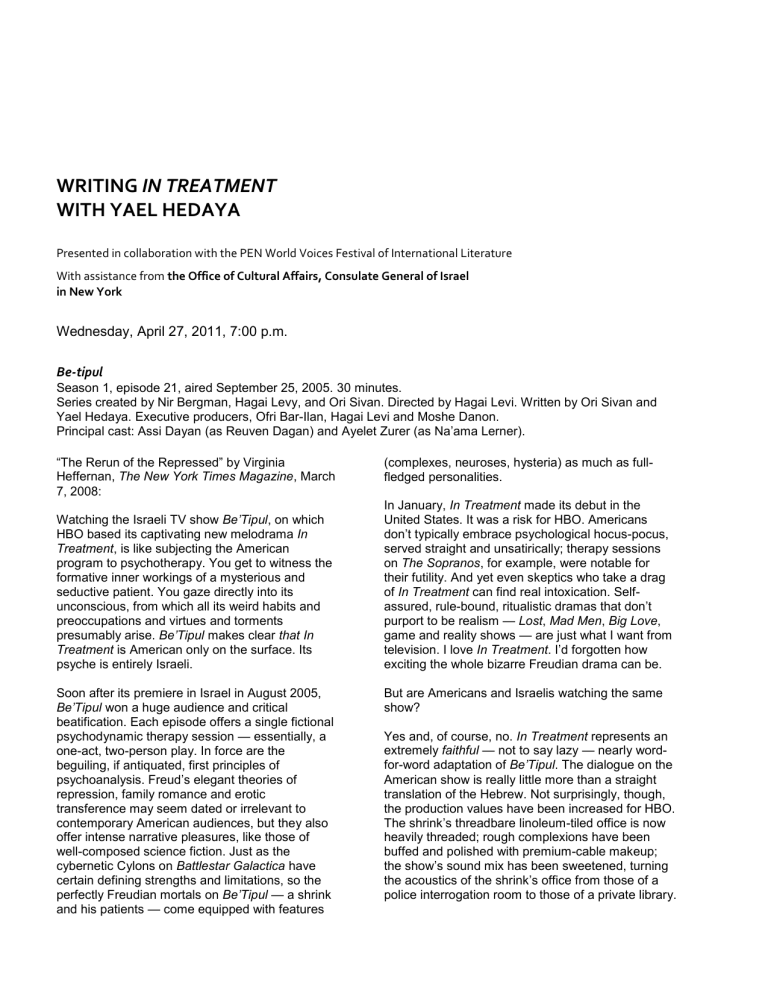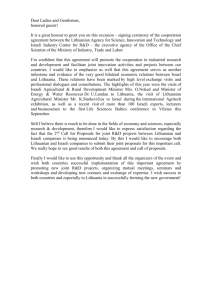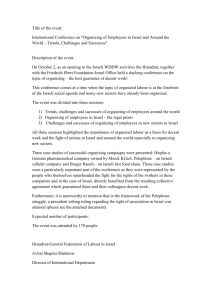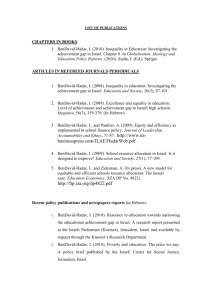WRITING IN TREATMENT WITH YAEL HEDAYA

WRITING IN TREATMENT
WITH YAEL HEDAYA
Presented in collaboration with the PEN World Voices Festival of International Literature
With assistance from the Office of Cultural Affairs, Consulate General of Israel in New York
Wednesday, April 27, 2011, 7:00 p.m.
Be-tipul
Season 1, episode 21, aired September 25, 2005. 30 minutes.
Series created by Nir Bergman, Hagai Levy, and Ori Sivan. Directed by Hagai Levi. Written by Ori Sivan and
Yael Hedaya. Executive producers, Ofri Bar-Ilan, Hagai Levi and Moshe Danon.
Principal cast: Assi Dayan (as Reuven Dagan) and Ayelet Zurer (as Na’ama Lerner).
“The Rerun of the Repressed” by Virginia
Heffernan, The New York Times Magazine , March
(complexes, neuroses, hysteria) as much as full-
7, 2008:
Watching the Israeli TV show Be’Tipul , on which
HBO based its captivating new melodrama In
Treatment , is like subjecting the American program to psychotherapy. You get to witness the formative inner workings of a mysterious and seductive patient. You gaze directly into its unconscious, from which all its weird habits and preoccupations and virtues and torments presumably arise. Be’Tipul makes clear that In
Treatment is American only on the surface. Its psyche is entirely Israeli.
Soon after its premiere in Israel in August 2005,
Be’Tipul won a huge audience and critical beatification. Each episode offers a single fictional psychodynamic therapy session — essentially, a one-act, two-person play. In force are the fledged personalities.
In January, In Treatment made its debut in the
United States. It was a risk for HBO. Americans don’t typically embrace psychological hocus-pocus, served straight and unsatirically; therapy sessions on The Sopranos , for example, were notable for their futility. And yet even skeptics who take a drag of In Treatment can find real intoxication. Selfassured, rulebound, ritualistic dramas that don’t purport to be realism — Lost , Mad Men , Big Love , game and reality shows — are just what I want from television. I love In Treatment . I’d forgotten how exciting the whole bizarre Freudian drama can be.
But are Americans and Israelis watching the same beguiling, if antiquated, first principles of psychoanalysis. Freud’s elegant theories of repression, family romance and erotic transference may seem dated or irrelevant to contemporary American audiences, but they also offer intense narrative pleasures, like those of well-composed science fiction. Just as the cybernetic Cylons on Battlestar Galactica have certain defining strengths and limitations, so the perfectly Freudian mortals on Be’Tipul — a shrink and his patients — come equipped with features show?
Yes and, of course, no. In Treatment represents an extremely faithful — not to say lazy — nearly wordfor-word adaptation of Be’Tipul . The dialogue on the
American show is really little more than a straight translation of the Hebrew. Not surprisingly, though, the production values have been increased for HBO.
The shrink’s threadbare linoleum-tiled office is now heavily threaded; rough complexions have been buffed and polished with premium-cable makeup; the show’s sound mix has been sweetened, turning the acoustics of the shrink’s office from those of a police interrogation room to those of a private library.
Everything looks and sounds, in short, richer on
HBO — especially the beleaguered therapist. In
Be’Tipul
Reuven
, Reuven (the brilliant Assi Dayan) is rumpled, sweaty and overweight. On he’s Gabriel Byrne as the dashing and fit Paul, sumptuously dressed in clothes rumpled only enough to make it clear t hey’re not permanent press. The décor of Paul’s office is vintage shrinkmagisterial: Tabriz rugs, soft inherited sofas and walls of impressive books and collectibles.
To hear Paul, in Byrne’s apparently irrepressible
Irish brogue, deliver lines originally uttered by offer coffee and tea to his patients? And why does he so regularly provide blankets, hugs, changes of clothing? All this seems way too intimate and lawsuit-baiting for a therapist in the United States.
On a show about psychotherapy, and only about psychotherapy, this lapse from verisimilitude must be significant. Isn’t that the point — that there are no accidents?
In Treatment ,
— in Israel — is to ask your brain to make several adjustments. Why does Paul, for instance, to Iraq to find closure by seeing his victims (just as
Yadin has visited Ramallah for the same reason), the differences between the Israeli and American circumstances come into relief. America’s war is so far off as to seem, often, abstract. Israel’s war — and enemy — is only a day trip away.
Another awkward adaptation involves a couple who come to Paul in anguish over a pregnancy. The man wants to keep the baby; the woman wants an abortion. In the Israeli version, the couple have to make a presentation before what the English subtitles call an “abortion committee” in order to justify a decision to terminate the pregnancy.
Planning this presentation consumes the pregnant woma n’s first few sessions. But on In Treatment , the
“committee” is only Paul himself. Too bad. How hard would it have been to introduce an anti-abortion family or community sitting in judgment on this couple? Perhaps that would have raised American religious and class issues that In Treatment was not prepared to explore.
At the same time, these cultural incongruities also
To make sense of the coffee, for instance, I changed my picture of Paul (he serves his patients abjectly, like a flight attendant, which also encourages dependence) when it seems, from the looks of Be’Tipul , that I may simply not have understood the conventions of Israeli therapists.
An d when it comes to Paul’s patient Alex — a
Navy pilot who accidentally bombed a madrassa in
Iraq — the cultural collisions become even more problematic. Alex (Blair Underwood) is the
American answer to Yadin (Lior Ashkenazi), a swaggering soldier who, in B e’Tipul , has produce an effect that suits In Treatment : they turn it eerie. The words and problems and solutions of another nation — one passably like ours, but different in both details and moral emphasis — are ventriloquized by people dressed up to look
American. This body-snatching is disconcerting, but ultimately ingenious, as it magnifies the hall-ofmirrors aspect of classical therapy, in which the patient is talking to the therapist (who is really her father) who is thinking about his own therapist (who is really his wife).
So on In Treatment we actually see Israelis, posing accidentally injured some children in Ramallah.
Alex is being treated in part for his repressed guilt.
At first, the analogy seems to track: both Alex’s and Yadin’s nations contend with ambivalence over their conflicts with Muslim populations. But as Americans, speaking about their hearts, minds and even violence in the Middle East. And it’s all ours to analyze. Is the violence the patients speak of projected internal violence? The violence within — or even between — America and Israel? Or is it the violence of translation? when Alex resolves (preposterously) to pop over
Museum of the Moving Image is grateful for the generous support of numerous corporations, foundations, and individuals. The Museum is housed in a building owned by the City of New York and receives significant support from the following public agencies: the New York City
Department of Cultural Affairs; New York City Economic Development Corporation; New York State Council on the Arts; Institute of
Museum and Library Services; National Endowment for the Humanities; National Endowment for the Arts; Natural Heritage Trust
(administered by the New York State Office of Parks, Recreation and Historic Preservation).
Copyright © 2011, Museum of the Moving Image









